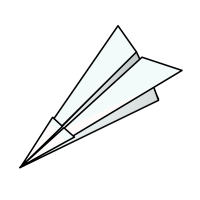What makes a good paper airplane?/Lesson Document
This constitutes the outline of an investigation into the action of air resistance on an airplane’s wings.
If true paper airplanes are to be used this activity is better for KS2 as the folding of paper airplanes with 30 children can be difficult. An alternative might be to use card to investigate wings of the same shape but a different surface area on the same body, e.g. a drinking straw or cardboard tube. To make this a genuinely fair test it is suggested that either a common launch mechanism is used or a series of test flights are undertaken to give an appropriate margin of error for results.
Designing and testing paper planes is a fun way to stimulate interest in the science of flight. You can take a design and investigate how the position of the wings, or the position of a weight affects how well the plane can fly. You might time how long they can stay in the air – just be prepared to practice doing this, as it is tricky. You can enter the results into a database programme/spreadsheet and then use it to analyse the results. The children can sort the results to find the best plane. Should the plane have weights on the nose? Some children could plot a scattergraph of wing position against the distance travelled – and find a pattern here.
| 1 | Plane testing | Wing position | Fly time |
| 2 | Mine | ||
| 3 | Hers | ||
| 4 | Theirs |
Instead of airplanes they can make paper spinners or gyroplanes. They can try different size wings, different wing cut-aways, or different numbers of paper clip weights, and they can time how long each design takes to fall. Again a database programme/spreadsheet will help them handle the results. They can select out the spinners with long wings and see whether those with more clips spin best. They can draw a bar graph and write their ideas on the print-out about what makes a good spinner.
You may like to refer to the following web references for additional information/ideas:
Examples of airplane designs imitating flying and gliding animals:
http://srel.uga.edu/kidsdoscience/sci-method-planes/airplane-designs.pdf
Examples of airplanes with instructions and videos on how to fold them:
http://www.funpaperairplanes.com/Plane%20Downloads.html
http://www.origami-resource-center.com/paper-airplane-instructions.html
Examples lessons on investigating the flights of paper airplanes using scientific method as an extended project:
http://camillasenior.homestead.com/paper_airplanes.pdf
http://srel.uga.edu/kidsdoscience/kidsdoscience-airplanes.htm

